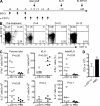In situ induction of dendritic cell-based T cell tolerance in humanized mice and nonhuman primates
- PMID: 22025302
- PMCID: PMC3256968
- DOI: 10.1084/jem.20111242
In situ induction of dendritic cell-based T cell tolerance in humanized mice and nonhuman primates
Erratum in
-
Correction: In situ induction of dendritic cell-based T cell tolerance in humanized mice and nonhuman primates.J Exp Med. 2016 Apr 4;213(4):643. doi: 10.1084/jem.2011124202182016c. Epub 2016 Mar 14. J Exp Med. 2016. PMID: 26976628 Free PMC article. No abstract available.
Abstract
Induction of antigen-specific T cell tolerance would aid treatment of diverse immunological disorders and help prevent allograft rejection and graft versus host disease. In this study, we establish a method of inducing antigen-specific T cell tolerance in situ in diabetic humanized mice and Rhesus monkeys receiving porcine islet xenografts. Antigen-specific T cell tolerance is induced by administration of an antibody ligating a particular epitope on ICAM-1 (intercellular adhesion molecule 1). Antibody-mediated ligation of ICAM-1 on dendritic cells (DCs) led to the arrest of DCs in a semimature stage in vitro and in vivo. Ablation of DCs from mice completely abrogated anti-ICAM-1-induced antigen-specific T cell tolerance. T cell responses to unrelated antigens remained unaffected. In situ induction of DC-mediated T cell tolerance using this method may represent a potent therapeutic tool for preventing graft rejection.
Figures








References
-
- Brehm M.A., Cuthbert A., Yang C., Miller D.M., DiIorio P., Laning J., Burzenski L., Gott B., Foreman O., Kavirayani A., et al. 2010. Parameters for establishing humanized mouse models to study human immunity: Analysis of human hematopoietic stem cell engraftment in three immunodeficient strains of mice bearing the IL2rgamma(null) mutation. Clin. Immunol. 135:84–98. 10.1016/j.clim.2009.12.008 - DOI - PMC - PubMed
Publication types
MeSH terms
Substances
Grants and funding
LinkOut - more resources
Full Text Sources
Other Literature Sources
Medical
Miscellaneous

